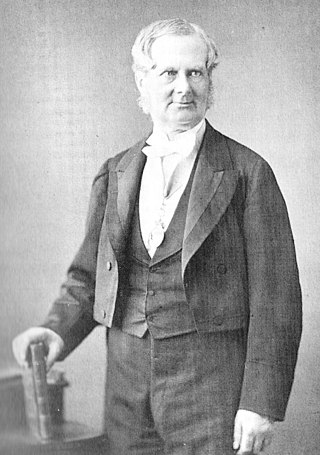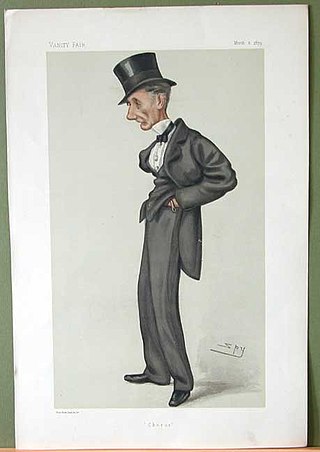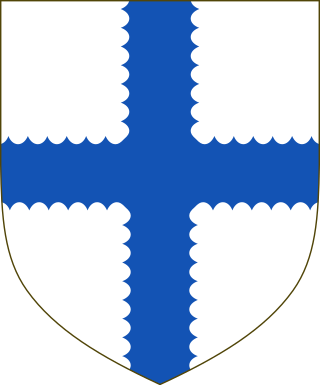Related Research Articles

Henry Somerset, 2nd Earl of Worcester was an English nobleman. He was the son of Charles Somerset, 1st Earl of Worcester and Elizabeth Herbert, 3rd Baroness Herbert. On his father's death on 15 April 1526, he succeeded as the second Earl of Worcester. From his mother, he inherited the title of Baron Herbert.

Sir John Bernard Burke, was a British genealogist and Ulster King of Arms, who helped publish Burke's Peerage.
The High Sheriff of Tipperary was the Sovereign's judicial representative in County Tipperary. Initially an office for a lifetime, assigned by the Sovereign, the High Sheriff became annually appointed from the Provisions of Oxford in 1258. Besides his judicial importance, he had ceremonial and administrative functions and executed High Court Writs.
John Burke was an Irish genealogist, and the original publisher of Burke's Peerage. He was the father of Sir Bernard Burke, a British officer of arms and genealogist.
The Edmonstone Baronetcy, of Duntreath in the County of Stirling, is a title in the Baronetage of Great Britain. It was created 20 May 1774 for Archibald Edmonstone, 11th of Duntreath, Member of Parliament for Dunbartonshire and Ayr Burghs. He was succeeded by his third but eldest surviving son, the second Baronet. He represented Dunbartonshire and Stirlingshire in the House of Commons. On his death the title passed to his eldest son, the third Baronet. He was a writer and traveller. He died without surviving issue and was succeeded by his half-brother, the fourth Baronet. He was an admiral in the Royal Navy and Member of Parliament.

Admiral Sir William Edmonstone, 4th Baronet CB, DL, also 14th of Duntreath, was a British naval commander, courtier and Conservative politician.

Charles Murray, 1st Earl of Dunmore PC was a British peer, previously Lord Charles Murray.

Elizabeth Hay, Countess of Erroll was an illegitimate daughter of King William IV of the United Kingdom and Dorothea Jordan. She married William Hay, 18th Earl of Erroll, and became Countess of Erroll on 4 December 1820 at age 19. Due to Hay's parentage, William Hay became Lord Steward of the Household. Elizabeth and William Hay married at St George's, Hanover Square. Hay is pictured in a FitzClarence family portrait in House of Dun, and kept a stone thrown at her father William IV and the gloves he wore on opening his first Parliament as mementos.

The Douglases of Mains are a branch of the Clan Douglas, related to the Lords of Douglas through Archibald I, Lord of Douglas. The first Laird obtained land through marriage into the Galbraith family, which had been granted land in New Kilpatrick by Maldowen, Earl of Lennox. The family produced minor nobles in the Scottish court, perhaps the most notable of which was Malcolm Douglas, the 8th Laird, executed for treason in Edinburgh for conspiracy in the Raid of Ruthven. His second son, Robert Douglas, was made Viscount of Belhaven and is buried in Holyrood Abbey. The family intermarried in the Glasgow area, having links with the Campbells of Blythswood, with landed families across Scotland and more latterly the United Kingdom. The title became extinct in the 20th century; the last 33+1⁄2 acres of the estate was sold to Dunbartonshire county and was subsequently used for the erection of the secondary school, Douglas Academy, in Milngavie prior to the death of the last heir in 1977.
The Sheriff of Bute was historically the office responsible for enforcing law and order on the Isle of Bute, Scotland and bringing criminals to justice.

Nicholas Hay, 2nd Earl of Erroll was a Scottish peer. He was the second Earl of Erroll and the third Lord Hay of Erroll.
James Balfour, 1st Baron Balfour of Glenawley or Clonawley was a Scottish nobleman and courtier who was one of the chief undertakers in the Plantation of Ulster. His third marriage to Anne Blayney caused a notable scandal.

John Lindsay, 17th Earl of Crawford, 1st Earl of Lindsay was a Scottish nobleman.
Sir Alexander Bannerman, 6th Baronet was a Scottish medical doctor and professor of medicine at the University of Aberdeen.
Sir Claud Hamilton of Shawfield, PC (Ire), also called of Leckprevick, a younger son of Claud Hamilton, 1st Lord Paisley in Scotland, was a gentleman of the privy chamber of King James VI and I, an undertaker in the Plantation of Ulster, and a privy counsellor in Ireland.

Henry Sinclair was a Scottish nobleman and 7th Lord Sinclair. In The Scots Peerage by James Balfour Paul he is designated as the 6th Lord Sinclair in descent starting from William Sinclair, 1st Earl of Caithness and 3rd Earl of Orkney, but historian Roland Saint-Clair designates him as the 7th Lord Sinclair in descent from the father of the 1st Earl of Caithness and 3rd Earl of Orkney, Henry II Sinclair, Earl of Orkney, who is the first person recorded as Lord Sinclair in public records. Roland Saint-Clair references this to an Act of the Scottish Parliament in which the 4th Lord Sinclair was made Lord Sinclair based on his descent from his great-grandfather, Henry II Sinclair, Earl of Orkney, the first Lord Sinclair. Bernard Burke, in his a Genealogical and Heraldic Dictionary of the Peerage and Baronetage of the British Empire, agrees with the numbering by Roland Saint-Clair and says that Henry Sinclair and William Sinclair were "in reality" the fourth and fifth Lords Sinclair respectively.

James Sinclair was a Scottish nobleman and the 8th Lord Sinclair. In The Scots Peerage by James Balfour Paul he is designated as the 7th Lord Sinclair in descent starting from William Sinclair, 1st Earl of Caithness and 3rd Earl of Orkney, but historian Roland Saint-Clair designates him as the 8th Lord Sinclair in descent from the father of the 1st Earl of Caithness and 3rd Earl of Orkney, Henry II Sinclair, Earl of Orkney, who is the first person recorded as Lord Sinclair in public records. Roland Saint-Clair references this to an Act of the Scottish Parliament in which the 4th Lord Sinclair was made Lord Sinclair based on his descent from his great-grandfather, Henry II Sinclair, Earl of Orkney, the first Lord Sinclair. Bernard Burke, in his a Genealogical and Heraldic Dictionary of the Peerage and Baronetage of the British Empire, agrees with the numbering by Roland Saint-Clair and says that Henry Sinclair and William Sinclair were "in reality" the fourth and fifth Lords Sinclair respectively.

Patrick Sinclair was a Scottish nobleman and the 9th Lord Sinclair. In The Scots Peerage by James Balfour Paul he is designated as the 8th Lord Sinclair in descent starting from William Sinclair, 1st Earl of Caithness and 3rd Earl of Orkney, but historian Roland Saint-Clair designates him as the 9th Lord Sinclair in descent from the father of the 1st Earl of Caithness and 3rd Earl of Orkney, Henry II Sinclair, Earl of Orkney, who is the first person recorded as Lord Sinclair in public records. Roland Saint-Clair references this to an Act of the Scottish Parliament in which the 4th Lord Sinclair was made Lord Sinclair based on his descent from his great-grandfather, Henry II Sinclair, Earl of Orkney, the first Lord Sinclair. Bernard Burke, in his a Genealogical and Heraldic Dictionary of the Peerage and Baronetage of the British Empire, agrees with the numbering by Roland Saint-Clair and says that Henry Sinclair and William Sinclair were "in reality" the fourth and fifth Lords Sinclair respectively.
Arthur Henry Johnstone-Douglas JP DL was a Scottish soldier and politician.
Robert Lindsay, 9th Lord Lindsay PC, was a Scottish landowner.
References
- Burke, John (1846). A Genealogical and Heraldic Dictionary of the Peerage and Baronetage of the British Empire (8th ed.). H. Colburn.